tow CHEVROLET TAHOE 2007 3.G User Guide
[x] Cancel search | Manufacturer: CHEVROLET, Model Year: 2007, Model line: TAHOE, Model: CHEVROLET TAHOE 2007 3.GPages: 634, PDF Size: 3.18 MB
Page 62 of 634
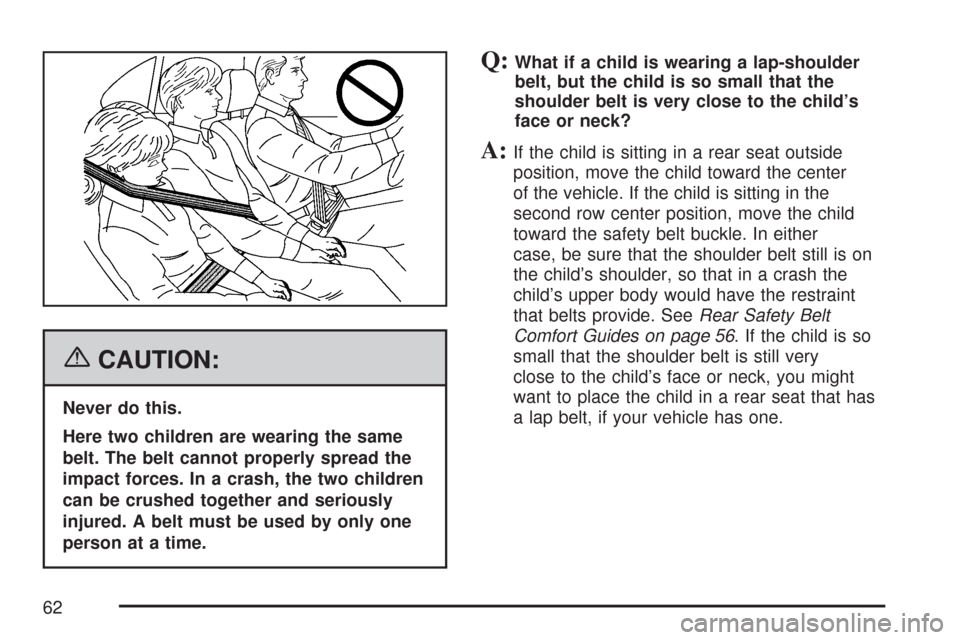
{CAUTION:
Never do this.
Here two children are wearing the same
belt. The belt cannot properly spread the
impact forces. In a crash, the two children
can be crushed together and seriously
injured. A belt must be used by only one
person at a time.
Q:What if a child is wearing a lap-shoulder
belt, but the child is so small that the
shoulder belt is very close to the child’s
face or neck?
A:If the child is sitting in a rear seat outside
position, move the child toward the center
of the vehicle. If the child is sitting in the
second row center position, move the child
toward the safety belt buckle. In either
case, be sure that the shoulder belt still is on
the child’s shoulder, so that in a crash the
child’s upper body would have the restraint
that belts provide. SeeRear Safety Belt
Comfort Guides on page 56. If the child is so
small that the shoulder belt is still very
close to the child’s face or neck, you might
want to place the child in a rear seat that has
a lap belt, if your vehicle has one.
62
Page 68 of 634
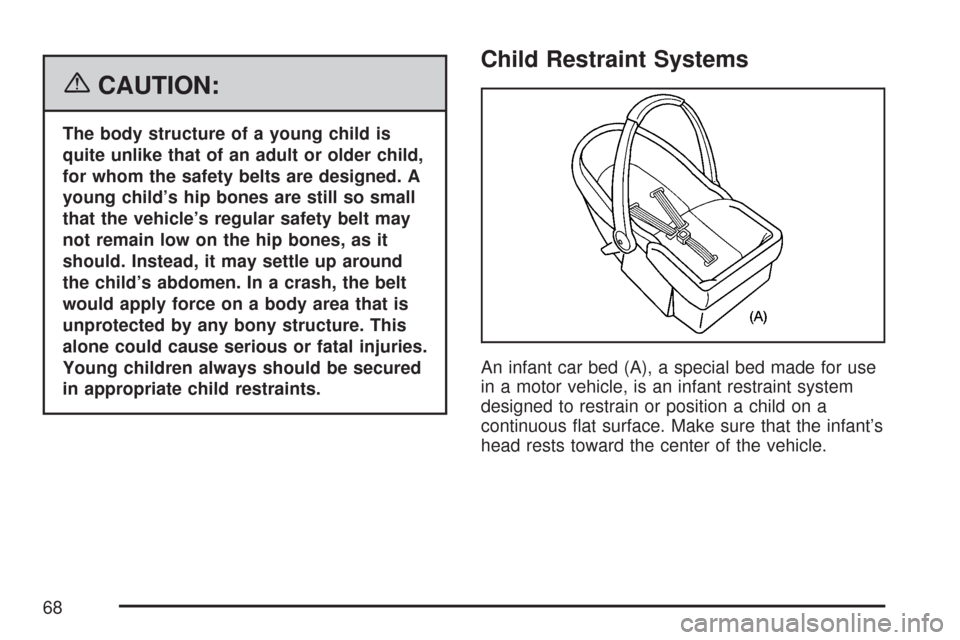
{CAUTION:
The body structure of a young child is
quite unlike that of an adult or older child,
for whom the safety belts are designed. A
young child’s hip bones are still so small
that the vehicle’s regular safety belt may
not remain low on the hip bones, as it
should. Instead, it may settle up around
the child’s abdomen. In a crash, the belt
would apply force on a body area that is
unprotected by any bony structure. This
alone could cause serious or fatal injuries.
Young children always should be secured
in appropriate child restraints.
Child Restraint Systems
An infant car bed (A), a special bed made for use
in a motor vehicle, is an infant restraint system
designed to restrain or position a child on a
continuous �at surface. Make sure that the infant’s
head rests toward the center of the vehicle.
68
Page 80 of 634
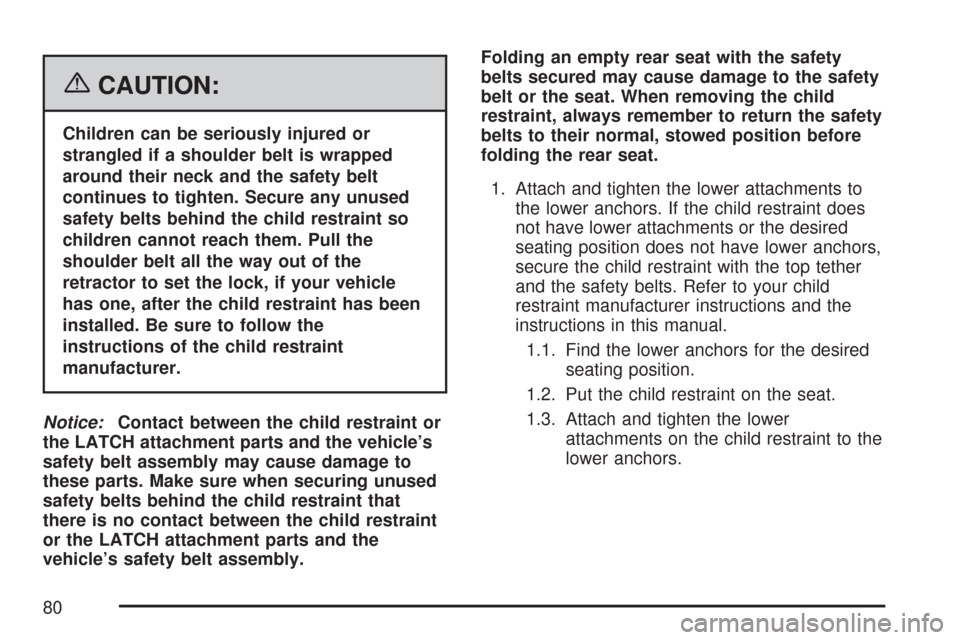
{CAUTION:
Children can be seriously injured or
strangled if a shoulder belt is wrapped
around their neck and the safety belt
continues to tighten. Secure any unused
safety belts behind the child restraint so
children cannot reach them. Pull the
shoulder belt all the way out of the
retractor to set the lock, if your vehicle
has one, after the child restraint has been
installed. Be sure to follow the
instructions of the child restraint
manufacturer.
Notice:Contact between the child restraint or
the LATCH attachment parts and the vehicle’s
safety belt assembly may cause damage to
these parts. Make sure when securing unused
safety belts behind the child restraint that
there is no contact between the child restraint
or the LATCH attachment parts and the
vehicle’s safety belt assembly.Folding an empty rear seat with the safety
belts secured may cause damage to the safety
belt or the seat. When removing the child
restraint, always remember to return the safety
belts to their normal, stowed position before
folding the rear seat.
1. Attach and tighten the lower attachments to
the lower anchors. If the child restraint does
not have lower attachments or the desired
seating position does not have lower anchors,
secure the child restraint with the top tether
and the safety belts. Refer to your child
restraint manufacturer instructions and the
instructions in this manual.
1.1. Find the lower anchors for the desired
seating position.
1.2. Put the child restraint on the seat.
1.3. Attach and tighten the lower
attachments on the child restraint to the
lower anchors.
80
Page 99 of 634
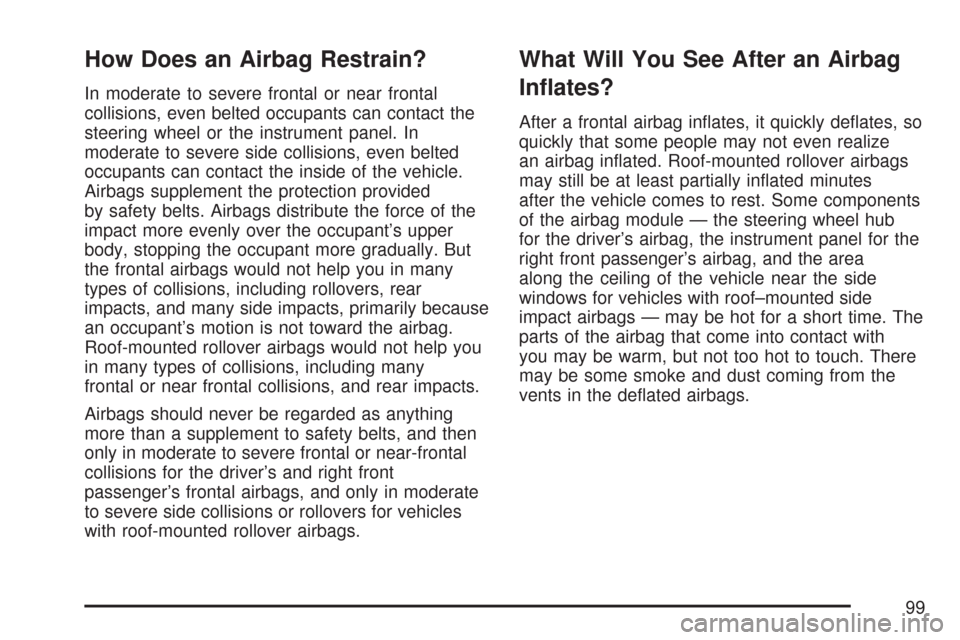
How Does an Airbag Restrain?
In moderate to severe frontal or near frontal
collisions, even belted occupants can contact the
steering wheel or the instrument panel. In
moderate to severe side collisions, even belted
occupants can contact the inside of the vehicle.
Airbags supplement the protection provided
by safety belts. Airbags distribute the force of the
impact more evenly over the occupant’s upper
body, stopping the occupant more gradually. But
the frontal airbags would not help you in many
types of collisions, including rollovers, rear
impacts, and many side impacts, primarily because
an occupant’s motion is not toward the airbag.
Roof-mounted rollover airbags would not help you
in many types of collisions, including many
frontal or near frontal collisions, and rear impacts.
Airbags should never be regarded as anything
more than a supplement to safety belts, and then
only in moderate to severe frontal or near-frontal
collisions for the driver’s and right front
passenger’s frontal airbags, and only in moderate
to severe side collisions or rollovers for vehicles
with roof-mounted rollover airbags.
What Will You See After an Airbag
In�ates?
After a frontal airbag in�ates, it quickly de�ates, so
quickly that some people may not even realize
an airbag in�ated. Roof-mounted rollover airbags
may still be at least partially in�ated minutes
after the vehicle comes to rest. Some components
of the airbag module — the steering wheel hub
for the driver’s airbag, the instrument panel for the
right front passenger’s airbag, and the area
along the ceiling of the vehicle near the side
windows for vehicles with roof–mounted side
impact airbags — may be hot for a short time. The
parts of the airbag that come into contact with
you may be warm, but not too hot to touch. There
may be some smoke and dust coming from the
vents in the de�ated airbags.
99
Page 105 of 634
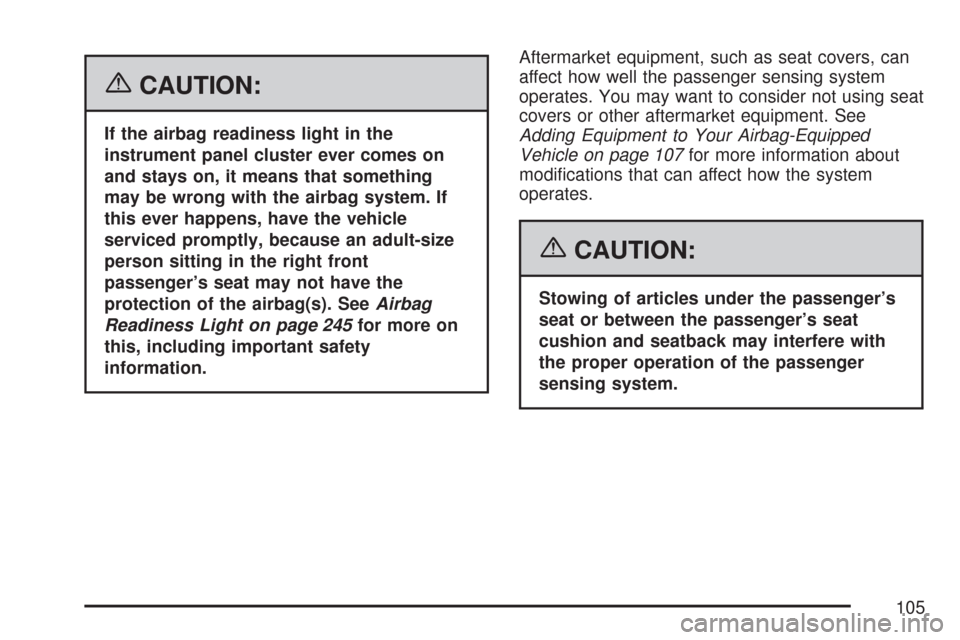
{CAUTION:
If the airbag readiness light in the
instrument panel cluster ever comes on
and stays on, it means that something
may be wrong with the airbag system. If
this ever happens, have the vehicle
serviced promptly, because an adult-size
person sitting in the right front
passenger’s seat may not have the
protection of the airbag(s). SeeAirbag
Readiness Light on page 245for more on
this, including important safety
information.Aftermarket equipment, such as seat covers, can
affect how well the passenger sensing system
operates. You may want to consider not using seat
covers or other aftermarket equipment. See
Adding Equipment to Your Airbag-Equipped
Vehicle on page 107for more information about
modi�cations that can affect how the system
operates.
{CAUTION:
Stowing of articles under the passenger’s
seat or between the passenger’s seat
cushion and seatback may interfere with
the proper operation of the passenger
sensing system.
105
Page 111 of 634
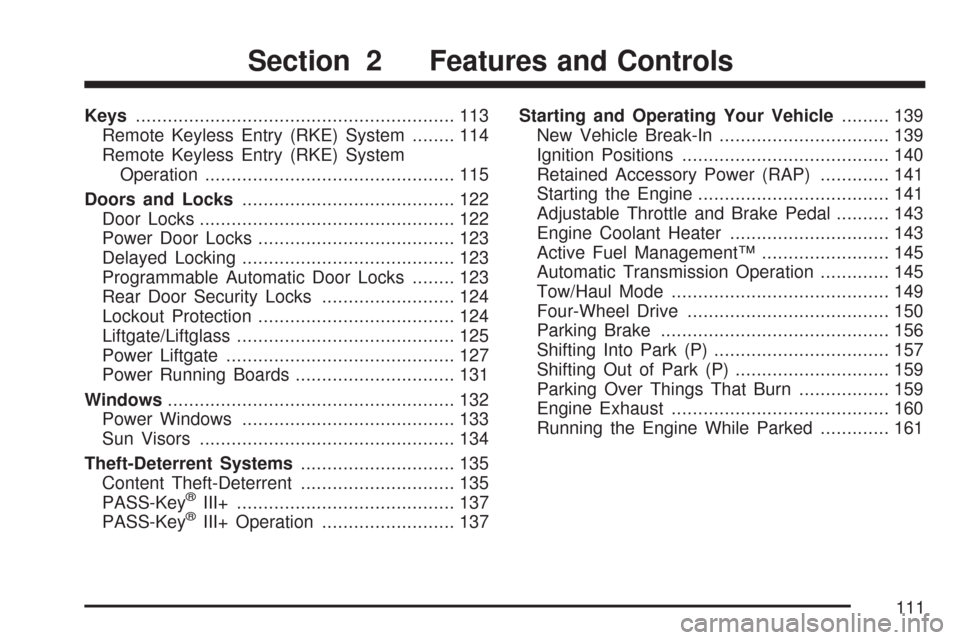
Keys............................................................ 113
Remote Keyless Entry (RKE) System........ 114
Remote Keyless Entry (RKE) System
Operation............................................... 115
Doors and Locks........................................ 122
Door Locks................................................ 122
Power Door Locks..................................... 123
Delayed Locking........................................ 123
Programmable Automatic Door Locks........ 123
Rear Door Security Locks......................... 124
Lockout Protection..................................... 124
Liftgate/Liftglass......................................... 125
Power Liftgate........................................... 127
Power Running Boards.............................. 131
Windows...................................................... 132
Power Windows........................................ 133
Sun Visors................................................ 134
Theft-Deterrent Systems............................. 135
Content Theft-Deterrent............................. 135
PASS-Key
®III+......................................... 137
PASS-Key®III+ Operation......................... 137Starting and Operating Your Vehicle......... 139
New Vehicle Break-In................................ 139
Ignition Positions....................................... 140
Retained Accessory Power (RAP)............. 141
Starting the Engine.................................... 141
Adjustable Throttle and Brake Pedal.......... 143
Engine Coolant Heater.............................. 143
Active Fuel Management™........................ 145
Automatic Transmission Operation............. 145
Tow/Haul Mode......................................... 149
Four-Wheel Drive...................................... 150
Parking Brake........................................... 156
Shifting Into Park (P) ................................. 157
Shifting Out of Park (P)............................. 159
Parking Over Things That Burn................. 159
Engine Exhaust......................................... 160
Running the Engine While Parked............. 161
Section 2 Features and Controls
111
Page 112 of 634
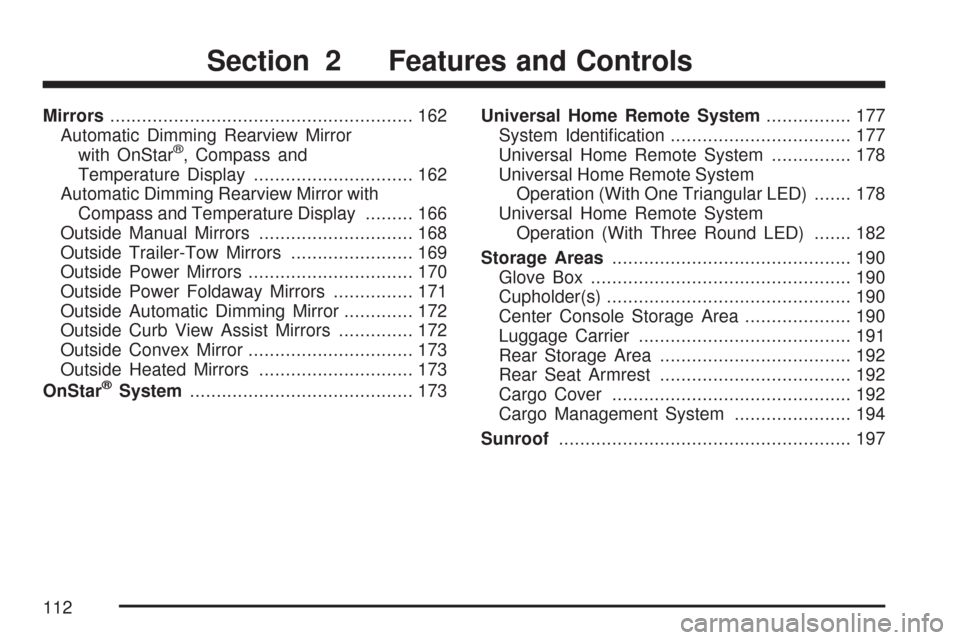
Mirrors......................................................... 162
Automatic Dimming Rearview Mirror
with OnStar
®, Compass and
Temperature Display.............................. 162
Automatic Dimming Rearview Mirror with
Compass and Temperature Display......... 166
Outside Manual Mirrors............................. 168
Outside Trailer-Tow Mirrors....................... 169
Outside Power Mirrors............................... 170
Outside Power Foldaway Mirrors............... 171
Outside Automatic Dimming Mirror............. 172
Outside Curb View Assist Mirrors.............. 172
Outside Convex Mirror............................... 173
Outside Heated Mirrors............................. 173
OnStar
®System.......................................... 173Universal Home Remote System................ 177
System Identi�cation.................................. 177
Universal Home Remote System............... 178
Universal Home Remote System
Operation (With One Triangular LED)....... 178
Universal Home Remote System
Operation (With Three Round LED)....... 182
Storage Areas............................................. 190
Glove Box................................................. 190
Cupholder(s).............................................. 190
Center Console Storage Area.................... 190
Luggage Carrier........................................ 191
Rear Storage Area.................................... 192
Rear Seat Armrest.................................... 192
Cargo Cover............................................. 192
Cargo Management System...................... 194
Sunroof....................................................... 197
Section 2 Features and Controls
112
Page 139 of 634
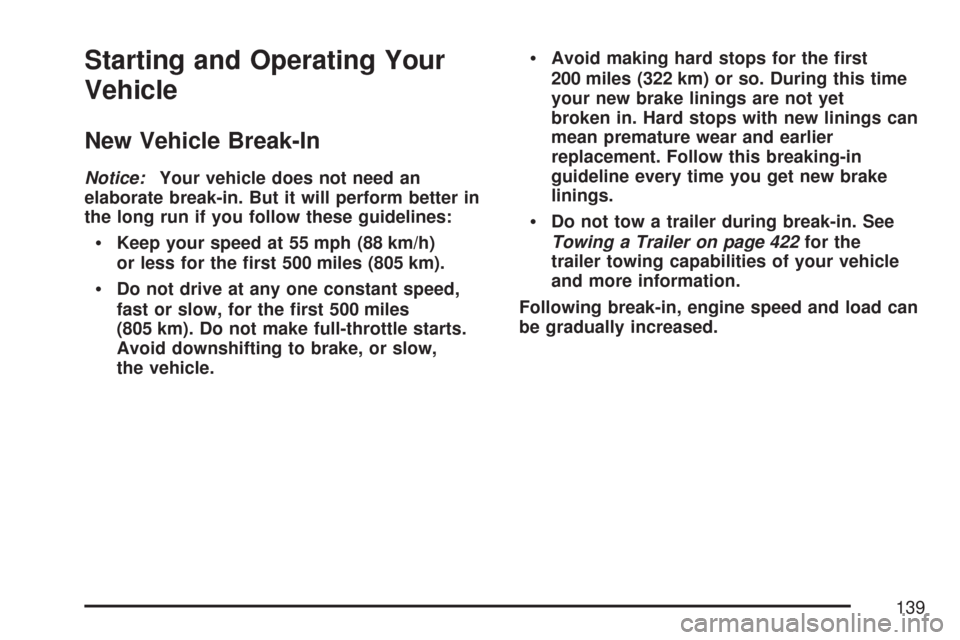
Starting and Operating Your
Vehicle
New Vehicle Break-In
Notice:Your vehicle does not need an
elaborate break-in. But it will perform better in
the long run if you follow these guidelines:
Keep your speed at 55 mph (88 km/h)
or less for the �rst 500 miles (805 km).
Do not drive at any one constant speed,
fast or slow, for the �rst 500 miles
(805 km). Do not make full-throttle starts.
Avoid downshifting to brake, or slow,
the vehicle.
Avoid making hard stops for the �rst
200 miles (322 km) or so. During this time
your new brake linings are not yet
broken in. Hard stops with new linings can
mean premature wear and earlier
replacement. Follow this breaking-in
guideline every time you get new brake
linings.
Do not tow a trailer during break-in. See
Towing a Trailer on page 422for the
trailer towing capabilities of your vehicle
and more information.
Following break-in, engine speed and load can
be gradually increased.
139
Page 143 of 634
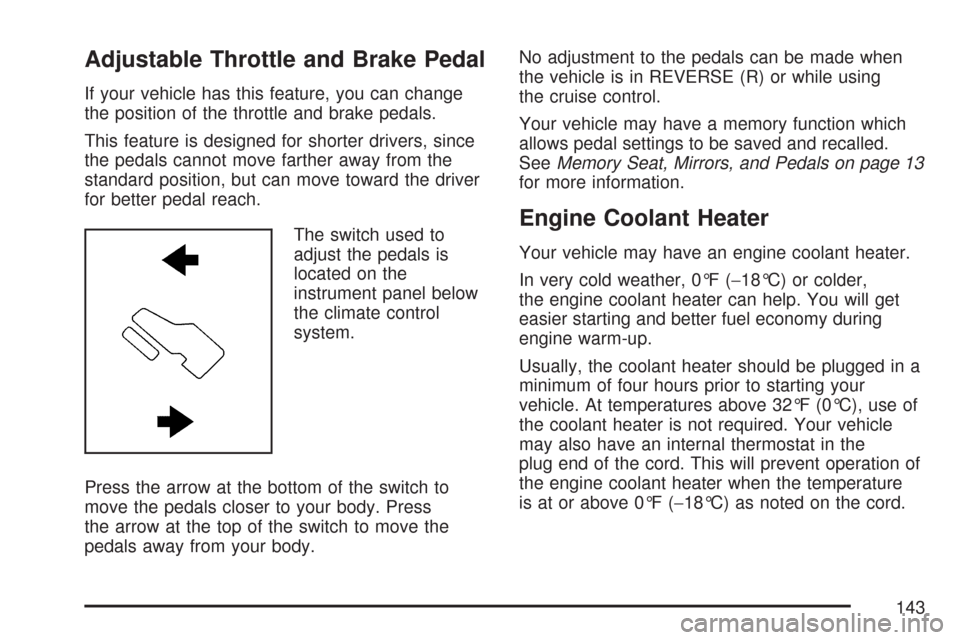
Adjustable Throttle and Brake Pedal
If your vehicle has this feature, you can change
the position of the throttle and brake pedals.
This feature is designed for shorter drivers, since
the pedals cannot move farther away from the
standard position, but can move toward the driver
for better pedal reach.
The switch used to
adjust the pedals is
located on the
instrument panel below
the climate control
system.
Press the arrow at the bottom of the switch to
move the pedals closer to your body. Press
the arrow at the top of the switch to move the
pedals away from your body.No adjustment to the pedals can be made when
the vehicle is in REVERSE (R) or while using
the cruise control.
Your vehicle may have a memory function which
allows pedal settings to be saved and recalled.
SeeMemory Seat, Mirrors, and Pedals on page 13
for more information.
Engine Coolant Heater
Your vehicle may have an engine coolant heater.
In very cold weather, 0°F (−18°C) or colder,
the engine coolant heater can help. You will get
easier starting and better fuel economy during
engine warm-up.
Usually, the coolant heater should be plugged in a
minimum of four hours prior to starting your
vehicle. At temperatures above 32°F (0°C), use of
the coolant heater is not required. Your vehicle
may also have an internal thermostat in the
plug end of the cord. This will prevent operation of
the engine coolant heater when the temperature
is at or above 0°F (−18°C) as noted on the cord.
143
Page 146 of 634
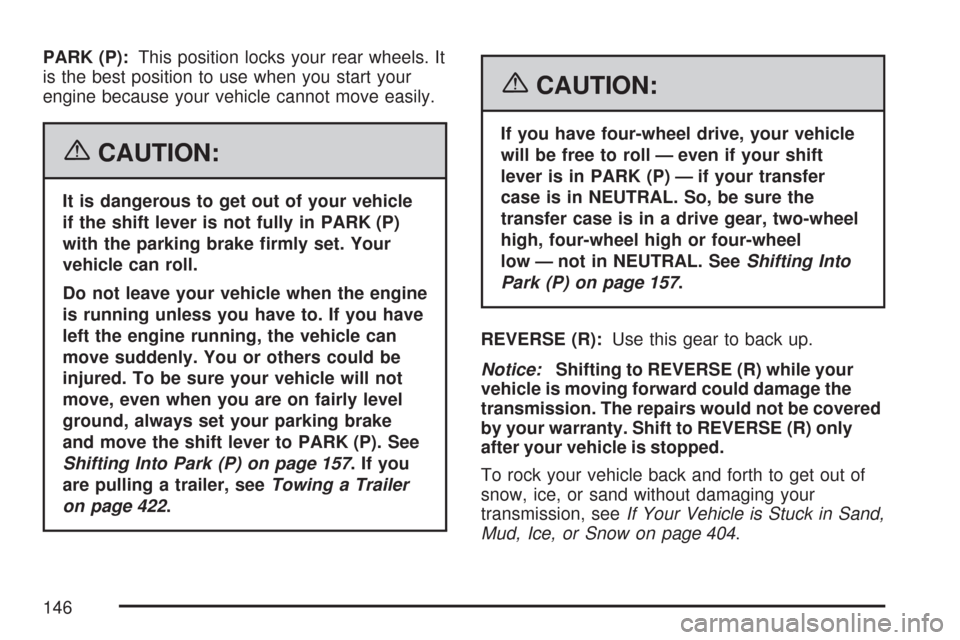
PARK (P):This position locks your rear wheels. It
is the best position to use when you start your
engine because your vehicle cannot move easily.
{CAUTION:
It is dangerous to get out of your vehicle
if the shift lever is not fully in PARK (P)
with the parking brake �rmly set. Your
vehicle can roll.
Do not leave your vehicle when the engine
is running unless you have to. If you have
left the engine running, the vehicle can
move suddenly. You or others could be
injured. To be sure your vehicle will not
move, even when you are on fairly level
ground, always set your parking brake
and move the shift lever to PARK (P). See
Shifting Into Park (P) on page 157.Ifyou
are pulling a trailer, seeTowing a Trailer
on page 422.
{CAUTION:
If you have four-wheel drive, your vehicle
will be free to roll — even if your shift
lever is in PARK (P) — if your transfer
case is in NEUTRAL. So, be sure the
transfer case is in a drive gear, two-wheel
high, four-wheel high or four-wheel
low — not in NEUTRAL. SeeShifting Into
Park (P) on page 157.
REVERSE (R):Use this gear to back up.
Notice:Shifting to REVERSE (R) while your
vehicle is moving forward could damage the
transmission. The repairs would not be covered
by your warranty. Shift to REVERSE (R) only
after your vehicle is stopped.
To rock your vehicle back and forth to get out of
snow, ice, or sand without damaging your
transmission, seeIf Your Vehicle is Stuck in Sand,
Mud, Ice, or Snow on page 404.
146